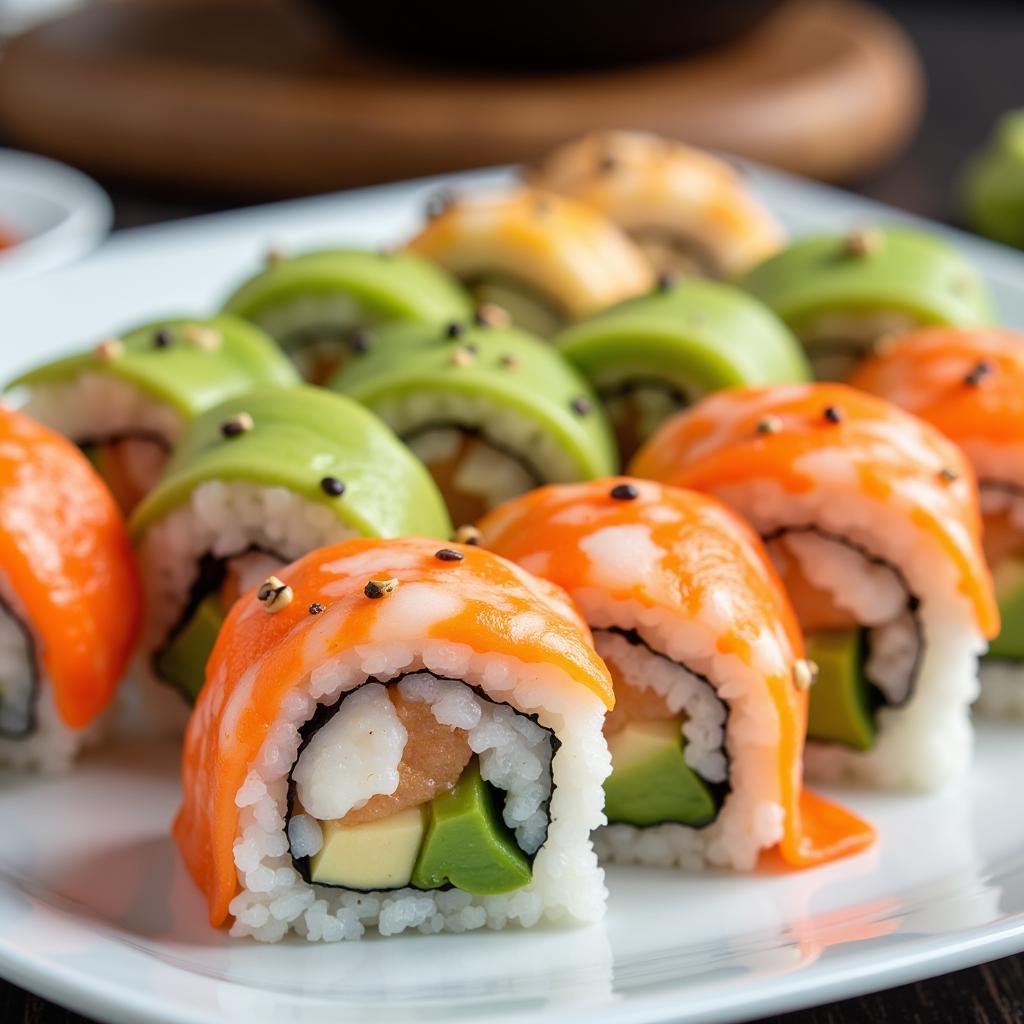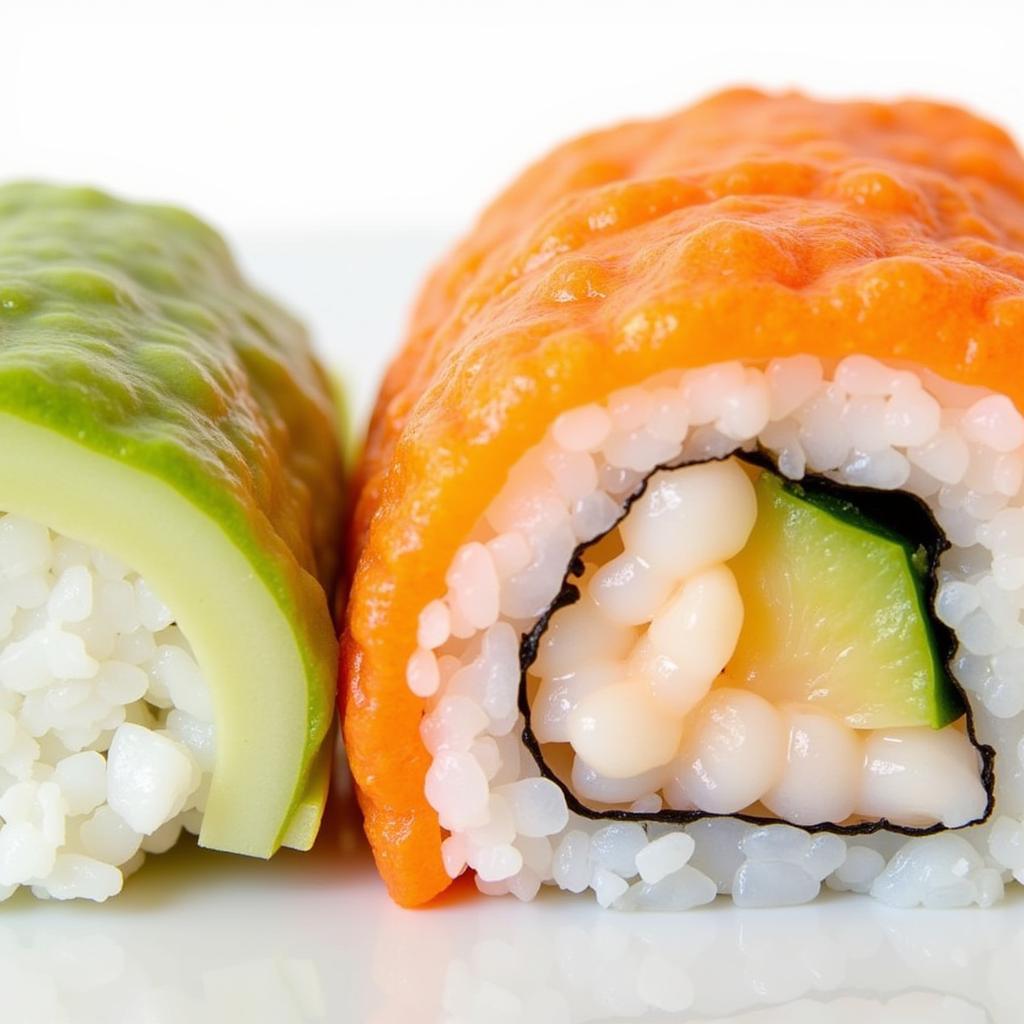Is Sushi A Soft Food? It’s a question that comes up surprisingly often, especially for those with dietary restrictions or dental issues. The answer, however, isn’t a simple yes or no. The texture of sushi can vary dramatically depending on the ingredients and preparation methods. Let’s explore the nuances of sushi texture and determine whether it fits into a soft food diet.
Sushi, with its artful presentation and delicate flavors, is more than just a meal; it’s an experience. But for those seeking soft food options, navigating the world of sushi can feel like a minefield. Understanding the components of sushi is key to determining its suitability for a soft food diet. From the sticky rice to the nori seaweed and the various fillings, each element contributes to the overall texture. After this insightful exploration, you might even be interested in exploring some fun food socks.
Decoding Sushi Texture: Rice, Fillings, and More
The foundation of most sushi is vinegared rice, which is typically slightly sticky and soft. This characteristic makes it relatively easy to chew and swallow. However, the firmness of the rice can vary depending on how it’s prepared. Overcooked rice can be mushy, while undercooked rice can be quite firm.
The Role of Fillings in Sushi Softness
The fillings are where the texture of sushi can change significantly. Soft fillings like avocado, cooked shrimp, or crab meat contribute to the overall softness of the sushi. Raw fish, like salmon or tuna, while tender, can present a slightly chewier texture. Vegetables like cucumber or carrots, depending on their preparation, can also introduce a degree of firmness.
 Soft Sushi Options: Avocado, Cooked Shrimp, and Cucumber Rolls
Soft Sushi Options: Avocado, Cooked Shrimp, and Cucumber Rolls
Is Sushi Suitable for a Soft Food Diet?
So, is sushi a soft food? The answer depends on the specific type of sushi. Nigiri, which is a slice of fish atop a mound of rice, can be relatively soft, especially with softer fish options. Maki rolls, which are rolled with nori seaweed and various fillings, can range from very soft to quite firm depending on the ingredients. For those on a soft food diet, choosing sushi with cooked fish, soft vegetables, and avoiding tempura-fried ingredients is key.
Certain types of sushi, such as California rolls with avocado, cucumber, and imitation crab meat, are generally considered soft. However, rolls containing tempura or crunchy vegetables should be avoided.
Considering Individual Needs and Preferences
Ultimately, whether sushi is considered a soft food depends on individual dietary needs and preferences. Those with extremely sensitive teeth or difficulty swallowing may need to exercise caution and choose sushi with exceptionally soft ingredients. Consulting with a doctor or dietitian is always recommended for personalized dietary advice.
 Sushi Texture Variations for Soft Food Diets
Sushi Texture Variations for Soft Food Diets
Navigating the Sushi Menu for Soft Options
When ordering sushi on a soft food diet, it’s crucial to communicate your needs to the restaurant staff. They can often recommend suitable options or make modifications to existing rolls. Asking for the rice to be prepared slightly softer can also contribute to a more comfortable eating experience. You might be surprised how accommodating sushi chefs can be! Perhaps after your delicious meal, you’d enjoy a charming food charm bracelet.
Dr. Emily Carter, a registered dietitian specializing in dietary restrictions, advises, “Communication is key when dining out with dietary needs. Don’t hesitate to ask about ingredients and preparation methods to ensure your meal aligns with your requirements.”
Conclusion: Enjoying Sushi on a Soft Food Diet
While not all sushi is inherently soft, there are plenty of options available for those on a soft food diet. By understanding the components of sushi and making informed choices, you can enjoy the delicate flavors and artistry of this Japanese cuisine without compromising your dietary needs. So, is sushi a soft food? Sometimes! It’s all about choosing wisely and enjoying the experience. Speaking of enjoyable experiences, check out these fun food t shirts.
 Choosing Sushi on a Soft Food Diet
Choosing Sushi on a Soft Food Diet
FAQ
- What are some examples of soft sushi rolls? California rolls, avocado rolls, and cucumber rolls are generally considered soft.
- What types of sushi should be avoided on a soft food diet? Avoid rolls containing tempura, crunchy vegetables, or very firm fish.
- Can I request modifications to sushi rolls to make them softer? Yes, many sushi restaurants are happy to accommodate dietary requests.
- Is raw fish considered a soft food? Raw fish can be tender, but it might not be suitable for everyone on a soft food diet.
- Is the rice in sushi always soft? The firmness of sushi rice can vary depending on preparation.
- What other soft Japanese dishes are available besides sushi? Miso soup, steamed fish, and tofu dishes are often soft and easy to eat.
- How can I determine if a specific sushi roll is soft enough for me? Ask the restaurant staff about the ingredients and preparation methods.
Other questions you might have:
- Are there specific types of sushi rice better for soft food diets?
- What are some alternatives to nori seaweed for sushi rolls?
- Can I make soft sushi at home?
Find more information on our website about food shaped lamps and hello kitty food plush. For any support, contact us at Phone: 02437655121, Email: minacones@gmail.com, or visit our address: 3PGH+8R9, ĐT70A, thôn Trung, Bắc Từ Liêm, Hà Nội, Việt Nam. We have a 24/7 customer support team.